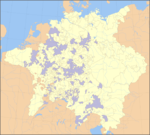Ochsenhausen Abbey
Ochsenhausen Abbey (formerly Ochsenhausen Priory; German: Reichskloster or Reichsabtei Ochsenhausen) was a Benedictine monastery in Ochsenhausen in the district of Biberach in Baden-Württemberg, Germany.
Imperial Abbey of Ochsenhausen Reichsabtei Ochsenhausen | |||||||||
|---|---|---|---|---|---|---|---|---|---|
| 1495–1803 | |||||||||
 Coat of arms
| |||||||||
| Status | Imperial Abbey | ||||||||
| Capital | Ochsenhausen Abbey | ||||||||
| Government | Principality | ||||||||
| Historical era | Middle Ages | ||||||||
• Dedicated | 1093 | ||||||||
• Gained independence | 1391 1495 | ||||||||
• Gained Reichsfreiheit | 1495 | ||||||||
• Serf rebellion | 1501 | ||||||||
• Secularised to von Metternich | 1803 | ||||||||
1806 | |||||||||
| |||||||||
History
The traditional story of the foundation, in which there may be some elements of truth, is that in the 9th century there was a nunnery here called "Hohenhusen", which was abandoned at the time of the Hungarian invasions in the early 10th century. A ploughing ox later turned up a chest of valuables buried by the nuns before their flight, and the monastery of Ochsenhausen was founded on that spot.
The first Abbey Church of Ochsenhausen was in fact dedicated in 1093. The monastery was initially a priory of St. Blaise's Abbey in the Black Forest, but gained the status of an independent abbey in 1391. In 1495 it became Reichsfrei (territorially independent).
The abbey was secularised in 1803 and in 1806 its territories were absorbed into the Kingdom of Württemberg.
Much of the buildings still survive. They were extensively refurbished in the Baroque style, so much so that Ochsenhausen is sometimes referred to as "Himmelreich des Barocks" ("Baroque heaven"). The Baden-Württemberg State Youth Music Academy[1] is accommodated in part of them. The former abbey church is now the parish church of St. George's.
Images
 Former abbey church of St. George's, Ochsenhausen
Former abbey church of St. George's, Ochsenhausen- Ochsenhausen Abbey
- Nave
- Altar of the Cross
- Crucifixion above Altar of the Cross
- Main altar
Crowning of Mary - Organ
- Pulpit
- An angel carrying the pulpit
- Madonna and child
- Baroque frescos on the vault
- Fresco of the Veneration of the Monstrance
- Secularisation charter, February 1803
 Church of Ochsenhausen Abbey postcard issued c. 1910.
Church of Ochsenhausen Abbey postcard issued c. 1910.
References
External links
| Wikimedia Commons has media related to Ochsenhausen Abbey. |
- (in German) Ochsenhausen Town Website
